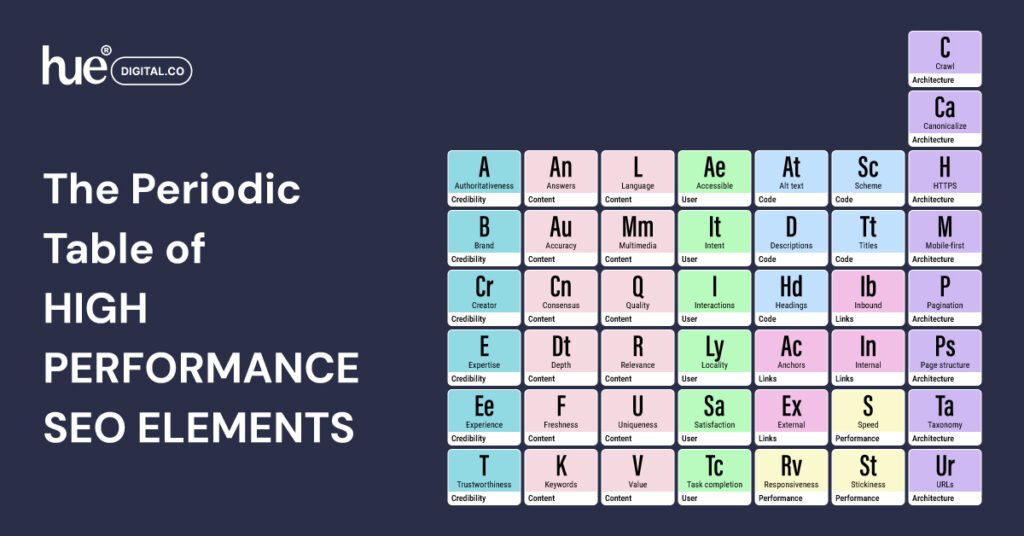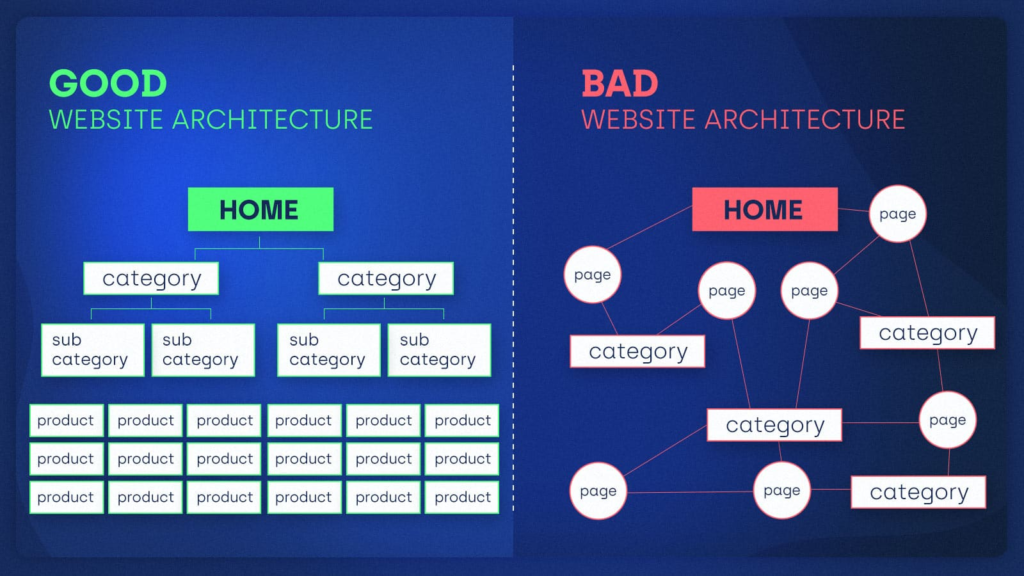The Periodic Table Of SEO Ranking Factors serves as a universally acknowledged and extensively utilized instrument crafted to aid in comprehending the fundamental components of a successful SEO approach.
This tool proves to be beneficial for individuals who are new to SEO, as well as for clients or stakeholders, in grasping the key factors that contribute to achieving success through consistent dedication.
The 44 SEO elements are categorized into groups, each of which is detailed below. It is important to note that no individual element or group holds more significance than any other element or group within this table.
When it comes to search engine optimization (SEO), the key is to excel in every aspect. The success lies in the interconnectedness of all the elements.
However, it is important to note that certain factors in the table hold more significance than others in terms of enhancing visibility on search engines. This significance may vary depending on the specific vertical, market, or niche in which you operate.

The Element Groups
The table has been structured into categories of related components. Every component listed in the table signifies a crucial factor to take into account for achieving success in SEO.
The primary table is divided into seven categories – Content, Architecture, Code, Credibility, Links, User, and Performance.
Content

Content is crucial for achieving a high ranking in search results. However, simply publishing content without a well-thought-out plan or strategy will not lead to success. The Content group of the SEO Periodic Table focuses on the essential components that Google and other search engines value when it comes to content. These elements primarily revolve around on-page SEO activities and potentially content marketing.
- Quality: You should create high-quality content that is helpful or useful for your target audience or customer. The content should be well-written and error-free.
- Keywords: To reach your target audience, you need to know what words they use. Make sure you incorporate target keywords naturally. And avoid excess keyword usage (repeating words in your text won’t help you rank better).
- Freshness: Creating timely content is important in some markets. Also, make sure to update content or remove stagnant pages to retain or improve rankings.
- Relevance: Make sure the topic of your page meets or exceeds the informational needs of the people who will ultimately consume the content.
- Accuracy: Your content should deliver on its promise. Avoid being clickbait.
- Depth: Publish comprehensive content. This doesn’t mean aiming for a certain word count. Instead, make your content thorough – aim for substance.
- Uniqueness: Differentiate your content. Find ways to add substantial value or originality.
- Answers: Create content that completely answers questions people ask.
- Multimedia: Images, video, and audio can help set content apart – and also could lead to visibility in other search features.
- Language: Your content should match the language of your target audience. If you want to reach English U.S. speakers, your primary language should not be French.
- Consensus: In some verticals, it’s important to align content with a majority of high-quality sources.
- Value: Each content piece you publish should have a clear focus or purpose for existing – and the primary purpose shouldn’t be to rank high in search results.
Architecture

An effective site layout can enhance your SEO strategies. Conversely, a poor site layout can lead to continuous dissatisfaction and subpar SEO outcomes.
The Architecture category of the SEO Periodic Table delves into the essential components necessary for developing a website that is user-friendly for both search engine crawlers and visitors, effectively communicating the purpose of your website and its pages. The majority of these components pertain to on-page and technical SEO practices.
- Crawl: You need to create a website that search engines can easily crawl, enabling them to fully render the content of all pages.
- Taxonomy: Structure websites for discovery and topical authority by interlinking topics and subtopics, and optimizing around entities (people, places, things, and ideas/concepts).
- Page structure: Strike the right balance between your main content, supplemental content and advertising. Users and search engines should be able to distinguish these three parts of the page.
- Mobile first: All SEO is mobile SEO. Design for the mobile experience first – but your site should offer the same user experience regardless of device.
- URLs: Keep URL structure simple. Use descriptive words.
- Canonicalize: Use canonicals and redirects to avoid duplicate content and consolidate content.
- Pagination: Split content wisely across a series of component pages.
- HTTPS: Make your website secure for visitors.
Code

Clean and valid code is essential for SEO, even though it may not be directly seen by users. While you don’t necessarily have to be a coder yourself, having a basic understanding of HTML, structured data types, and programming languages like JavaScript and Python is important in order to grasp how they influence SEO.
The Code section of the SEO Periodic Table delves into the crucial components that improve user experience and assist search engine crawlers in interpreting and comprehending your content. Many of these components are related to on-page and technical SEO tasks.
- Titles: Write descriptive, optimized titles that attract clicks.
- Descriptions: Meta descriptions should describe what the pages are about.
- Headings: Add relevant keywords to headings and subheadings.
- Image Alt: This key accessibility practice can boost image SEO.
- Schema: Use structured data to identify entities and enhance SERP snippets.
Credibility

Google’s Search Quality Evaluator Guidelines emphasize the importance of a concept known as E-E-A-T, which stands for Experience, Expertise, Authoritativeness and Trustworthiness. Stanford’s Guidelines for Web Credibility, which pre-date E-E-A-T, offer 10 guidelines for building the credibility of any websites.
Although these concepts do not directly affect rankings, they can provide valuable insights into the preferences of search algorithms.
The Credibility group concentrates on factors that affect your reputation, which in turn can affect your visibility in organic search results. These factors encompass various aspects of SEO and brand marketing.
- Trustworthiness: Demonstrate accuracy, honesty, safety, and reliability in all your content across your entire website. This element overlaps with Experience, Expertise and Authoritativeness.
- Experience: Content creators should demonstrate first-hand or life experience relating to a topic.
- Expertise: The content should be created based on skills or deep subject matter knowledge or familiarity related to a topic.
- Authoritativeness: You want to become a recognized, “go-to” resource based on what the web says about you (via links, mentions and other signals).
- Brand: The way people perceive and identify a brand (your logo, colors, fonts, slogans, etc.) on the web. All assets become part of your brand story (e.g., expert articles, references, reviews, recommendations).
- Creator: Education level, professional experience, peer judgment, citations, achievements and credentials all contribute to brand perception and E-E-A-T.
Links

The emergence of Google in 1998 brought about a significant shift in the importance of links. Google’s groundbreaking PageRank algorithm highlighted the significance of links in determining a website’s search performance. However, as time passed, Google began to prioritize the concepts of “quality” and “quantity” when considering the impact of links.
The Links group primarily focuses on aspects related to the links associated with your website. This includes both inbound and outbound links, which play a crucial role in providing valuable context to users and search engines. Link building, particularly in terms of acquiring backlinks, has traditionally been considered a specialized area within the field of SEO. On-page and technical SEO typically handle the management of internal and external links.
- Anchors: This is the text that other sites use when linking to yours, or the text you use when linking to internal or external webpages. Anchor text should be short, provide context and be relevant to the linked resource.
- Inbound: Your content should attract quality links from trusted, relevant and popular third-party websites – the types of links you’d find valuable even if Google didn’t exist.
- Internal: These links guide users – via navigation, breadcrumbs and in-content links – to pages on your own site. Internal links also can signal which pages you value most.
- External: Link out to reputable, credible, useful third-party resources to add value for your audience/users.
User
One of Google’s core beliefs is “Focus on the user and all else will follow.” This is exactly why you must focus on understanding what matters most to your users – and then figure out the smartest way to give it to them. Google is also watching everything people do within Search results.
The SEO Periodic Table’s User group delves into elements centered around individuals, aiming to deliver the optimal user experience. Since these elements are influenced by people, any steps taken in this area should focus on revealing practical insights that can enhance your SEO strategies to cater more effectively to your audience or users.
- Accessible: Provide an accessible experience for all
- Intent: Understand the true meaning (e.g., fears, needs, wants) behind keywords or topics.
- Interactions: Search engines track and analyze SERP clicks, hovers, scrolls, swipes, query chains and more.
- Locality: Create unique, authentic experiences for a country, region, state, city, town or neighborhood.
- Satisfaction: Think user utility. Fully satisfy people so they leave and go to a competitor.
- Task completion: Help people achieve goals. Lead people to key website conversion points.
Performance
Once you have designed and fine-tuned your pages, how do they fare in actual user experience? While some of these factors may not significantly affect rankings, poorly performing pages can lead to user frustration, ultimately affecting engagement, conversions, and revenue.
The Performance category in the SEO Periodic Table delves into elements that contribute to enhancing on-page user experience. Many of these elements fall under the realm of technical SEO.
- Speed: Pages should load quickly, on any device.
- Responsiveness: Reduce the time between a user interaction and an updated page content.
- Visual stability: Movement of content on your page (e.g., text, images, buttons) should be minimal upon page load.